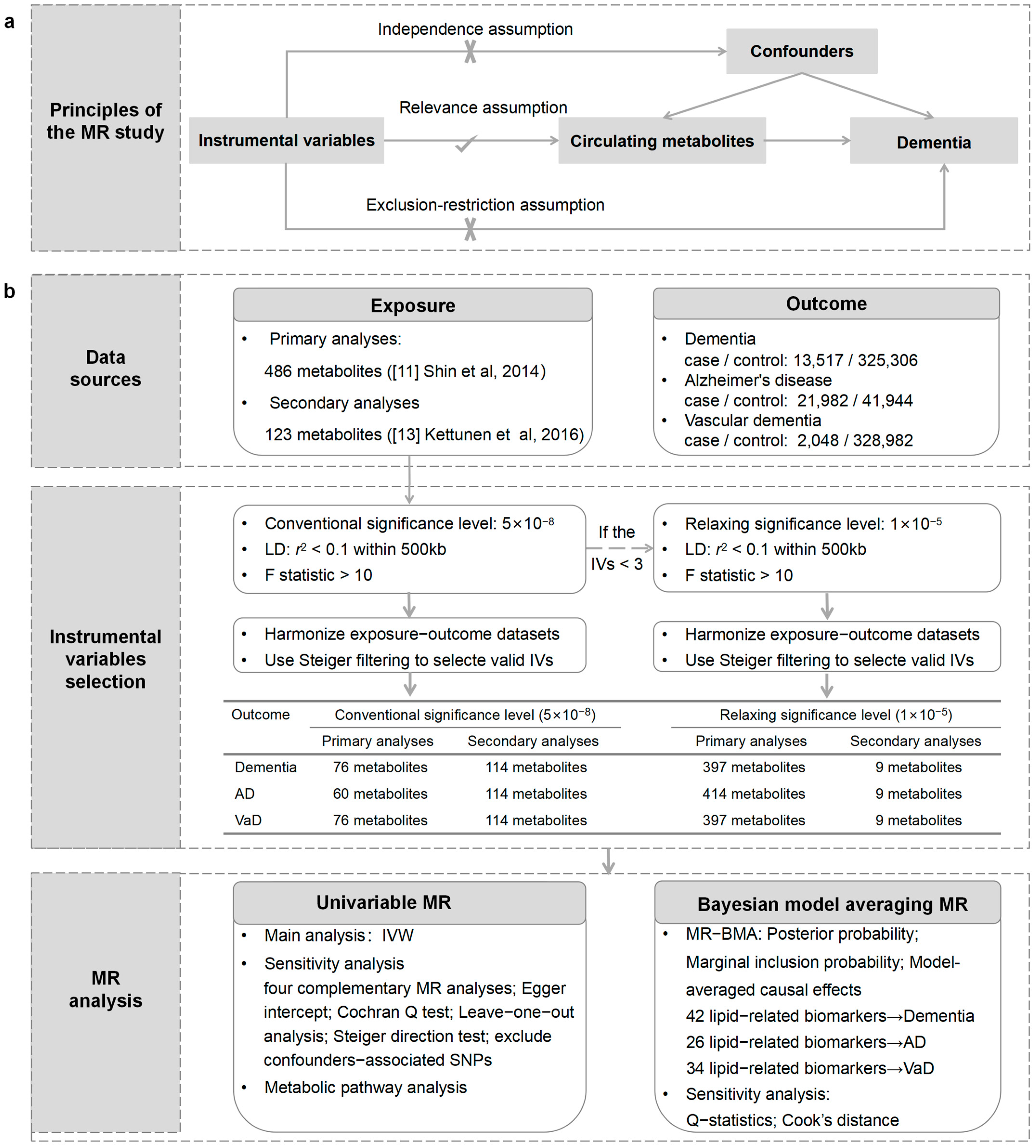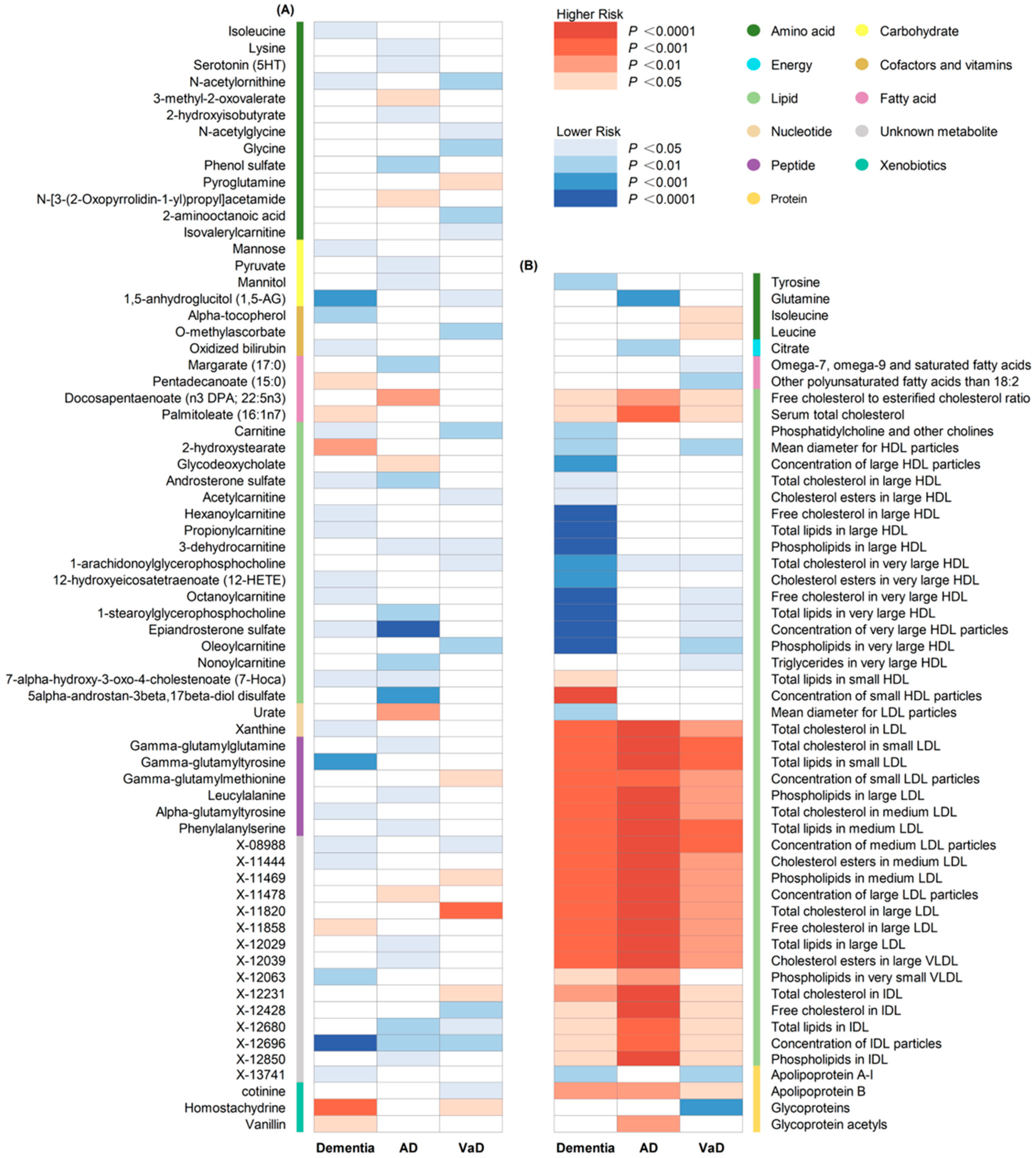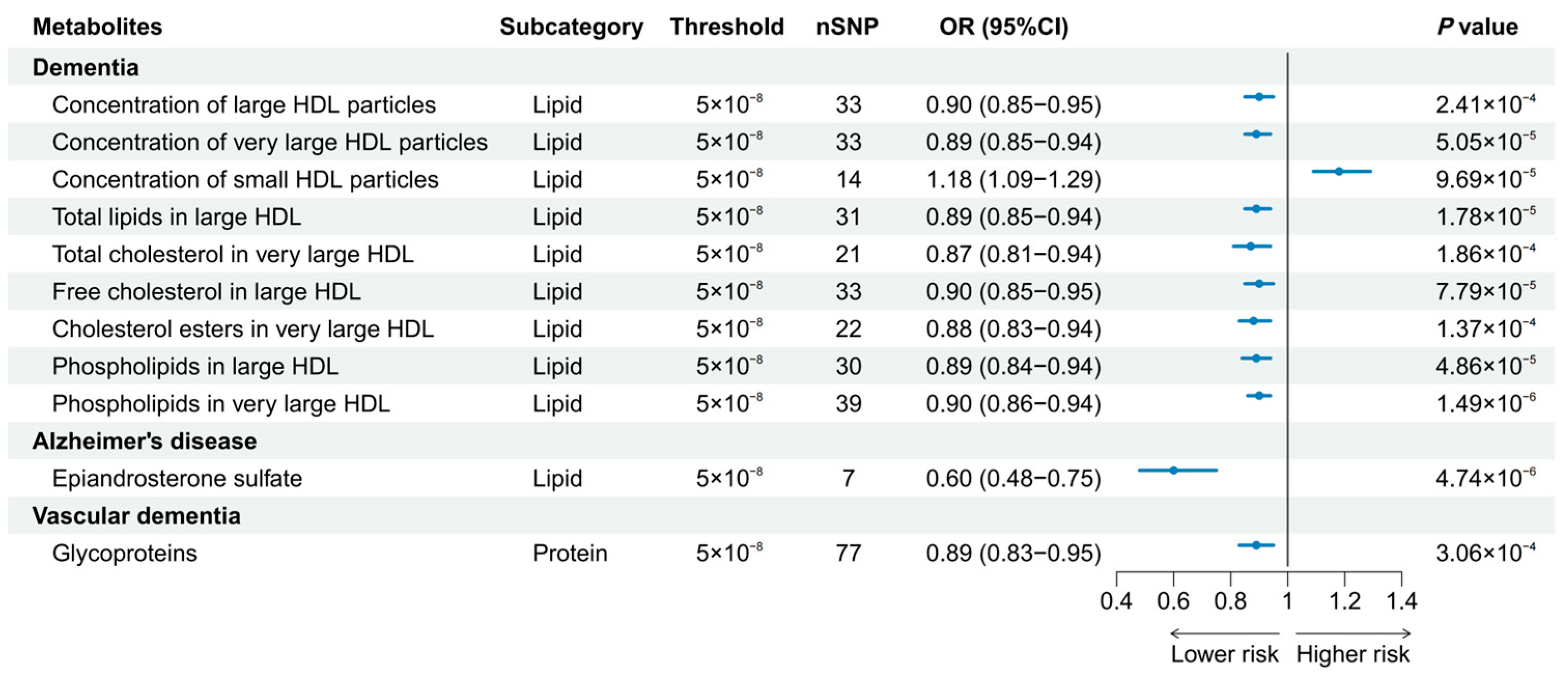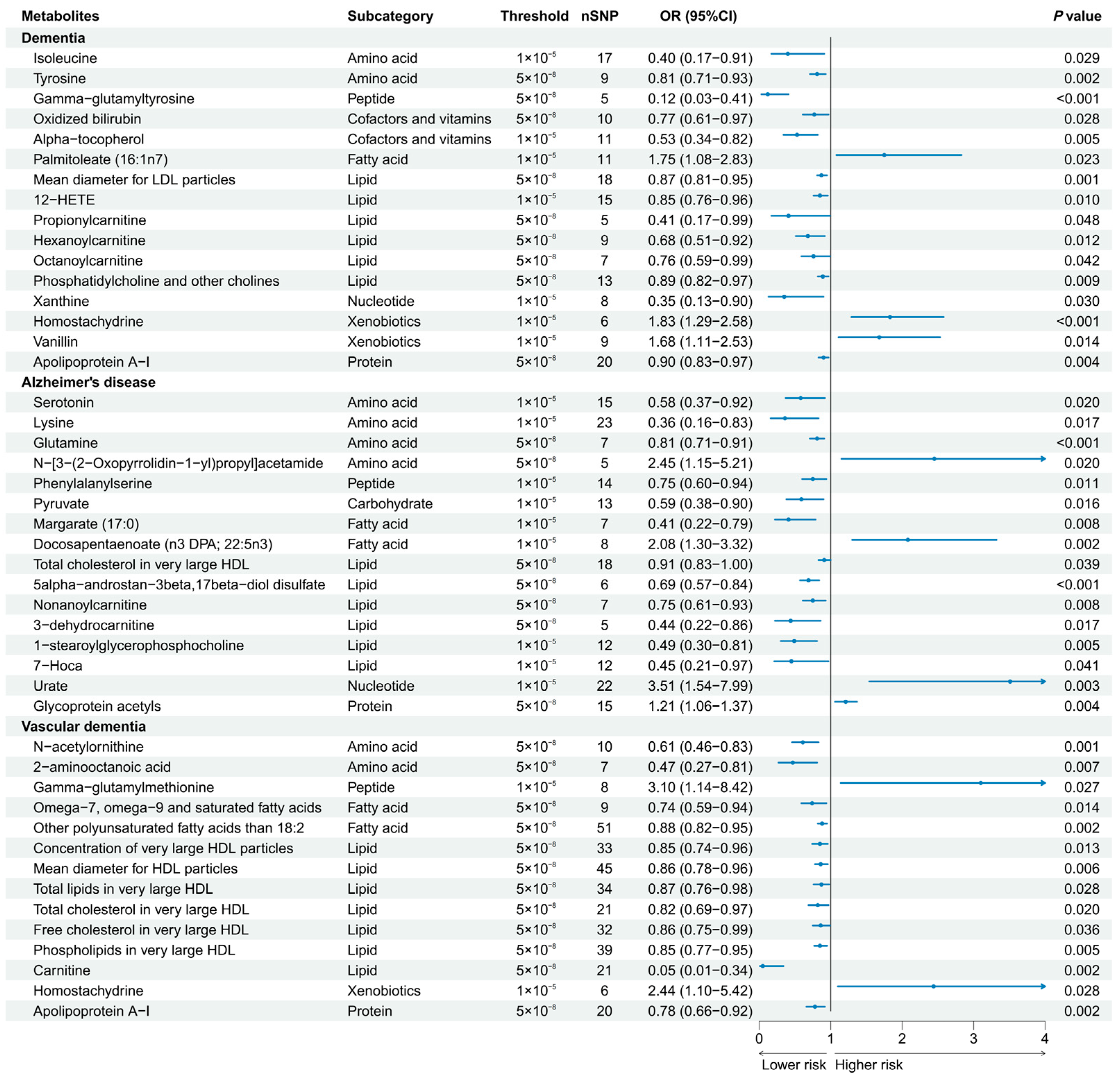Causal Association between Circulating Metabolites and Dementia: A Mendelian Randomization Study
Abstract
:1. Introduction
2. Materials and Methods
2.1. Study Design
2.2. GWAS Data Sources for Circulating Metabolites and Dementia
2.3. Selection of IVs
2.4. Univariable MR
2.5. MR-BMA Analysis
2.6. Statistical Analysis
2.7. Metabolic Pathway Analysis
3. Results
3.1. Strength of the IVs
3.2. Univariable MR Analyses
3.3. MR-BMA Analyses
3.4. Metabolic Pathway Analysis
4. Discussion
5. Conclusions
Supplementary Materials
Author Contributions
Funding
Institutional Review Board Statement
Informed Consent Statement
Data Availability Statement
Acknowledgments
Conflicts of Interest
References
- Grande, G.; Qiu, C.; Fratiglioni, L. Prevention of dementia in an ageing world: Evidence and biological rationale. Ageing Res. Rev. 2020, 64, 101045. [Google Scholar] [CrossRef] [PubMed]
- GBD 2019 Dementia Forecasting Collaborators. Estimation of the global prevalence of dementia in 2019 and forecasted prevalence in 2050: An analysis for the Global Burden of Disease Study 2019. Lancet Public Health 2022, 7, e105–e125. [Google Scholar] [CrossRef] [PubMed]
- Lefevre-Arbogast, S.; Wagner, M.; Proust-Lima, C.; Samieri, C. Nutrition and Metabolic Profiles in the Natural History of Dementia: Recent Insights from Systems Biology and Life Course Epidemiology. Curr. Nutr. Rep. 2019, 8, 256–269. [Google Scholar] [CrossRef] [PubMed]
- Zhu, Z.; Lin, Y.; Li, X.; Driver, J.A.; Liang, L. Shared genetic architecture between metabolic traits and Alzheimer’s disease: A large-scale genome-wide cross-trait analysis. Hum. Genet. 2019, 138, 271–285. [Google Scholar] [CrossRef]
- de la Monte, S.M.; Tong, M. Brain metabolic dysfunction at the core of Alzheimer’s disease. Biochem. Pharmacol. 2014, 88, 548–559. [Google Scholar] [CrossRef]
- Zhang, X.; Hu, W.; Wang, Y.; Wang, W.; Liao, H.; Zhang, X.; Kiburg, K.V.; Shang, X.; Bulloch, G.; Huang, Y.; et al. Plasma metabolomic profiles of dementia: A prospective study of 110,655 participants in the UK Biobank. BMC Med. 2022, 20, 252. [Google Scholar] [CrossRef] [PubMed]
- Proitsi, P.; Kuh, D.; Wong, A.; Maddock, J.; Bendayan, R.; Wulaningsih, W.; Hardy, R.; Richards, M. Lifetime cognition and late midlife blood metabolites: Findings from a British birth cohort. Transl. Psychiatry 2018, 8, 203. [Google Scholar] [CrossRef]
- van der Lee, S.J.; Teunissen, C.E.; Pool, R.; Shipley, M.J.; Teumer, A.; Chouraki, V.; Melo van Lent, D.; Tynkkynen, J.; Fischer, K.; Hernesniemi, J.; et al. Circulating metabolites and general cognitive ability and dementia: Evidence from 11 cohort studies. Alzheimer’s Dement. J. Alzheimer’s Assoc. 2018, 14, 707–722. [Google Scholar] [CrossRef]
- Tynkkynen, J.; Chouraki, V.; van der Lee, S.J.; Hernesniemi, J.; Yang, Q.; Li, S.; Beiser, A.; Larson, M.G.; Sääksjärvi, K.; Shipley, M.J.; et al. Association of branched-chain amino acids and other circulating metabolites with risk of incident dementia and Alzheimer’s disease: A prospective study in eight cohorts. Alzheimer’s Dement. J. Alzheimer’s Assoc. 2018, 14, 723–733. [Google Scholar] [CrossRef]
- Sanderson, E.; Richardson, T.G.; Morris, T.T.; Tilling, K.; Davey Smith, G. Estimation of causal effects of a time-varying exposure at multiple time points through multivariable mendelian randomization. PLoS Genet. 2022, 18, e1010290. [Google Scholar] [CrossRef]
- Shin, S.Y.; Fauman, E.B.; Petersen, A.K.; Krumsiek, J.; Santos, R.; Huang, J.; Arnold, M.; Erte, I.; Forgetta, V.; Yang, T.P.; et al. An atlas of genetic influences on human blood metabolites. Nat. Genet. 2014, 46, 543–550. [Google Scholar] [CrossRef] [PubMed]
- Skrivankova, V.W.; Richmond, R.C.; Woolf, B.A.R.; Yarmolinsky, J.; Davies, N.M.; Swanson, S.A.; VanderWeele, T.J.; Higgins, J.P.T.; Timpson, N.J.; Dimou, N.; et al. Strengthening the Reporting of Observational Studies in Epidemiology Using Mendelian Randomization: The STROBE-MR Statement. Jama 2021, 326, 1614–1621. [Google Scholar] [CrossRef] [PubMed]
- Kettunen, J.; Demirkan, A.; Wurtz, P.; Draisma, H.H.; Haller, T.; Rawal, R.; Vaarhorst, A.; Kangas, A.J.; Lyytikainen, L.P.; Pirinen, M.; et al. Genome-wide study for circulating metabolites identifies 62 loci and reveals novel systemic effects of LPA. Nat. Commun. 2016, 7, 11122. [Google Scholar] [CrossRef]
- Kurki, M.I.; Karjalainen, J.; Palta, P.; Sipilä, T.P.; Kristiansson, K.; Donner, K.M.; Reeve, M.P.; Laivuori, H.; Aavikko, M.; Kaunisto, M.A.; et al. FinnGen provides genetic insights from a well-phenotyped isolated population. Nature 2023, 613, 508–518. [Google Scholar] [CrossRef]
- Kunkle, B.W.; Grenier-Boley, B.; Sims, R.; Bis, J.C.; Damotte, V.; Naj, A.C.; Boland, A.; Vronskaya, M.; van der Lee, S.J.; Amlie-Wolf, A.; et al. Genetic meta-analysis of diagnosed Alzheimer’s disease identifies new risk loci and implicates Abeta, tau, immunity and lipid processing. Nat. Genet. 2019, 51, 414–430. [Google Scholar] [CrossRef]
- Burgess, S.; Davies, N.M.; Thompson, S.G. Bias due to participant overlap in two-sample Mendelian randomization. Genet. Epidemiol. 2016, 40, 597–608. [Google Scholar] [CrossRef]
- Sanna, S.; van Zuydam, N.R.; Mahajan, A.; Kurilshikov, A.; Vich Vila, A.; Vosa, U.; Mujagic, Z.; Masclee, A.A.M.; Jonkers, D.; Oosting, M.; et al. Causal relationships among the gut microbiome, short-chain fatty acids and metabolic diseases. Nat. Genet. 2019, 51, 600–605. [Google Scholar] [CrossRef]
- Yang, J.; Yan, B.; Zhao, B.; Fan, Y.; He, X.; Yang, L.; Ma, Q.; Zheng, J.; Wang, W.; Bai, L.; et al. Assessing the Causal Effects of Human Serum Metabolites on 5 Major Psychiatric Disorders. Schizophr. Bull. 2020, 46, 804–813. [Google Scholar] [CrossRef]
- Hemani, G.; Tilling, K.; Davey Smith, G. Orienting the causal relationship between imprecisely measured traits using GWAS summary data. PLoS Genet. 2017, 13, e1007081. [Google Scholar]
- Pierce, B.L.; Ahsan, H.; Vanderweele, T.J. Power and instrument strength requirements for Mendelian randomization studies using multiple genetic variants. Int. J. Epidemiol. 2011, 40, 740–752. [Google Scholar] [CrossRef]
- Burgess, S.; Thompson, S.G. Avoiding bias from weak instruments in Mendelian randomization studies. Int. J. Epidemiol. 2011, 40, 755–764. [Google Scholar] [CrossRef] [PubMed]
- Cai, J.; Li, X.; Wu, S.; Tian, Y.; Zhang, Y.; Wei, Z.; Jin, Z.; Li, X.; Chen, X.; Chen, W.X. Assessing the causal association between human blood metabolites and the risk of epilepsy. J. Transl. Med. 2022, 20, 437. [Google Scholar] [CrossRef] [PubMed]
- Wu, F.; Huang, Y.; Hu, J.; Shao, Z. Mendelian randomization study of inflammatory bowel disease and bone mineral density. BMC Med. 2020, 18, 312. [Google Scholar] [CrossRef] [PubMed]
- Xue, H.; Shen, X.; Pan, W. Constrained maximum likelihood-based Mendelian randomization robust to both correlated and uncorrelated pleiotropic effects. Am. J. Hum. Genet. 2021, 108, 1251–1269. [Google Scholar] [CrossRef]
- Yeung, C.H.C.; Au Yeung, S.L.; Kwok, M.K.; Zhao, J.V.; Schooling, C.M. The influence of growth and sex hormones on risk of alzheimer’s disease: A mendelian randomization study. Eur. J. Epidemiol. 2023, 38, 745–755. [Google Scholar] [CrossRef]
- Zuber, V.; Colijn, J.M.; Klaver, C.; Burgess, S. Selecting likely causal risk factors from high-throughput experiments using multivariable Mendelian randomization. Nat. Commun. 2020, 11, 29. [Google Scholar] [CrossRef]
- Levin, M.G.; Zuber, V.; Walker, V.M.; Klarin, D.; Lynch, J.; Malik, R.; Aday, A.W.; Bottolo, L.; Pradhan, A.D.; Dichgans, M.; et al. Prioritizing the Role of Major Lipoproteins and Subfractions as Risk Factors for Peripheral Artery Disease. Circulation 2021, 144, 353–364. [Google Scholar] [CrossRef]
- Hottman, D.A.; Chernick, D.; Cheng, S.; Wang, Z.; Li, L. HDL and cognition in neurodegenerative disorders. Neurobiol. Dis. 2014, 72 Pt A, 22–36. [Google Scholar] [CrossRef]
- Kjeldsen, E.W.; Thomassen, J.Q.; Juul Rasmussen, I.; Nordestgaard, B.G.; Tybjærg-Hansen, A.; Frikke-Schmidt, R. Plasma high-density lipoprotein cholesterol and risk of dementia: Observational and genetic studies. Cardiovasc. Res. 2022, 118, 1330–1343. [Google Scholar] [CrossRef]
- Sáiz-Vazquez, O.; Puente-Martínez, A.; Ubillos-Landa, S.; Pacheco-Bonrostro, J.; Santabárbara, J. Cholesterol and Alzheimer’s Disease Risk: A Meta-Meta-Analysis. Brain Sci. 2020, 10, 386. [Google Scholar] [CrossRef]
- Li, R.; Chen, J.X.; Lu, Q.; Geng, T.T.; Xia, P.F.; Wang, Y.; Chen, L.K.; Shan, Z.L.; Pan, A.; Liu, G. Associations of lipoprotein subclasses with risk of all-cause and cardiovascular disease mortality in individuals with type 2 diabetes: A prospective cohort study. Diabetes Obes. Metab. 2023, 25, 3259–3267. [Google Scholar] [CrossRef] [PubMed]
- Proitsi, P.; Lupton, M.K.; Velayudhan, L.; Newhouse, S.; Fogh, I.; Tsolaki, M.; Daniilidou, M.; Pritchard, M.; Kloszewska, I.; Soininen, H.; et al. Genetic predisposition to increased blood cholesterol and triglyceride lipid levels and risk of Alzheimer disease: A Mendelian randomization analysis. PLoS Med. 2014, 11, e1001713. [Google Scholar] [CrossRef] [PubMed]
- Østergaard, S.D.; Mukherjee, S.; Sharp, S.J.; Proitsi, P.; Lotta, L.A.; Day, F.; Perry, J.R.; Boehme, K.L.; Walter, S.; Kauwe, J.S.; et al. Associations between Potentially Modifiable Risk Factors and Alzheimer Disease: A Mendelian Randomization Study. PLoS Med. 2015, 12, e1001841. [Google Scholar] [CrossRef] [PubMed]
- Fazio, S.; Pamir, N. HDL Particle Size and Functional Heterogeneity. Circ. Res. 2016, 119, 704–707. [Google Scholar] [CrossRef] [PubMed]
- Kontush, A.; Lhomme, M.; Chapman, M.J. Unraveling the complexities of the HDL lipidome. J. Lipid Res. 2013, 54, 2950–2963. [Google Scholar] [CrossRef]
- Turri, M.; Marchi, C.; Adorni, M.P.; Calabresi, L.; Zimetti, F. Emerging role of HDL in brain cholesterol metabolism and neurodegenerative disorders. Biochim. Biophys. Acta Mol. Cell Biol. Lipids 2022, 1867, 159123. [Google Scholar] [CrossRef]
- Moayyeri, A.; Cheung, C.L.; Tan, K.C.; Morris, J.A.; Cerani, A.; Mohney, R.P.; Richards, J.B.; Hammond, C.; Spector, T.D.; Menni, C. Metabolomic Pathways to Osteoporosis in Middle-Aged Women: A Genome-Metabolome-Wide Mendelian Randomization Study. J. Bone Min. Res. 2018, 33, 643–650. [Google Scholar] [CrossRef]
- Sun, L.; Guo, D.; Jia, Y.; Shi, M.; Yang, P.; Wang, Y.; Liu, F.; Chen, G.C.; Zhang, Y.; Zhu, Z. Association between Human Blood Metabolome and the Risk of Alzheimer’s Disease. Ann. Neurol. 2022, 92, 756–767. [Google Scholar] [CrossRef]
- Pérez-Jiménez, M.M.; Monje-Moreno, J.M.; Brokate-Llanos, A.M.; Venegas-Calerón, M.; Sánchez-García, A.; Sansigre, P.; Valladares, A.; Esteban-García, S.; Suárez-Pereira, I.; Vitorica, J.; et al. Steroid hormones sulfatase inactivation extends lifespan and ameliorates age-related diseases. Nat. Commun. 2021, 12, 49. [Google Scholar] [CrossRef]
- Reily, C.; Stewart, T.J.; Renfrow, M.B.; Novak, J. Glycosylation in health and disease. Nat. Rev. Nephrol. 2019, 15, 346–366. [Google Scholar] [CrossRef]
- Haran, J.P.; Bhattarai, S.K.; Foley, S.E.; Dutta, P.; Ward, D.V.; Bucci, V.; McCormick, B.A. Alzheimer’s Disease Microbiome Is Associated with Dysregulation of the Anti-Inflammatory P-Glycoprotein Pathway. mBio 2019, 10, e00632-19. [Google Scholar] [CrossRef]
- Llorens, F.; Hermann, P.; Villar-Piqué, A.; Diaz-Lucena, D.; Nägga, K.; Hansson, O.; Santana, I.; Schmitz, M.; Schmidt, C.; Varges, D.; et al. Cerebrospinal fluid lipocalin 2 as a novel biomarker for the differential diagnosis of vascular dementia. Nat. Commun. 2020, 11, 619. [Google Scholar] [CrossRef]
- Horgusluoglu, E.; Neff, R.; Song, W.M.; Wang, M.; Wang, Q.; Arnold, M.; Krumsiek, J.; Galindo-Prieto, B.; Ming, C.; Nho, K.; et al. Integrative metabolomics-genomics approach reveals key metabolic pathways and regulators of Alzheimer’s disease. Alzheimer’s Dement. J. Alzheimer’s Assoc. 2022, 18, 1260–1278. [Google Scholar] [CrossRef] [PubMed]
- Glenn, J.M.; Madero, E.N.; Bott, N.T. Dietary Protein and Amino Acid Intake: Links to the Maintenance of Cognitive Health. Nutrients 2019, 11, 1315. [Google Scholar] [CrossRef] [PubMed]
- Reuter, S.E.; Evans, A.M. Carnitine and acylcarnitines: Pharmacokinetic, pharmacological and clinical aspects. Clin. Pharmacokinet. 2012, 51, 553–572. [Google Scholar] [CrossRef] [PubMed]
- Nie, A.; Sun, B.; Fu, Z.; Yu, D. Roles of aminoacyl-tRNA synthetases in immune regulation and immune diseases. Cell Death Dis. 2019, 10, 901. [Google Scholar] [CrossRef]
- Polis, B.; Samson, A.O. Role of the metabolism of branched-chain amino acids in the development of Alzheimer’s disease and other metabolic disorders. Neural Regen. Res. 2020, 15, 1460–1470. [Google Scholar] [CrossRef]
- González-Domínguez, R.; Castellano-Escuder, P.; Lefèvre-Arbogast, S.; Low, D.Y.; Du Preez, A.; Ruigrok, S.R.; Lee, H.; Helmer, C.; Pallàs, M.; Urpi-Sarda, M.; et al. Apolipoprotein E and sex modulate fatty acid metabolism in a prospective observational study of cognitive decline. Alzheimers Res. Ther. 2022, 14, 1. [Google Scholar] [CrossRef]




| Metabolite Traits | Rank | MIP | Average Effect | Empirical p Values |
|---|---|---|---|---|
| Dementia | ||||
| Concentration of very large HDL particles | 1 | 0.139 | −0.025 | 0.002 |
| Mean diameter for HDL particles | 2 | 0.127 | −0.018 | 0.005 |
| Free cholesterol in very large HDL particles | 3 | 0.116 | −0.02 | 0.097 |
| Phospholipids in very large HDL particles | 4 | 0.110 | −0.015 | 0.028 |
| Total lipids in very large HDL particles | 5 | 0.084 | −0.007 | 0.059 |
| AD | ||||
| Total cholesterol in very large HDL particles | 1 | 0.579 | −0.094 | 0.005 |
| Serum total cholesterol | 2 | 0.101 | −0.031 | 0.084 |
| Free cholesterol to esterified cholesterol ratio | 3 | 0.062 | 0.012 | 0.291 |
| Glycoprotein acetyls | 4 | 0.044 | 0.005 | 0.628 |
| Phospholipids in medium LDL particles | 5 | 0.044 | 0.007 | 0.985 |
| VaD | ||||
| Omega-7, omega-9 and saturated fatty acids | 1 | 0.311 | −0.13 | 0.012 |
| Serum total cholesterol | 2 | 0.186 | −0.103 | 0.001 |
| Triglycerides in very large HDL particles | 3 | 0.101 | −0.02 | 0.026 |
| Total cholesterol in medium LDL particles | 4 | 0.101 | 0.039 | 0.012 |
| Total cholesterol in LDL particles | 5 | 0.1 | 0.041 | 0.007 |
| Model | Posterior Probability | Causal Estimate |
|---|---|---|
| Dementia | ||
| Mean diameter for HDL particles | 0.055 | −0.109 |
| Concentration of very large HDL particles | 0.054 | −0.124 |
| Phospholipids in very large HDL particles | 0.047 | −0.112 |
| Free cholesterol in very large HDL particles | 0.042 | −0.126 |
| Total lipids in very large HDL particles | 0.029 | −0.115 |
| Cholesterol esters in large HDL particles | 0.028 | −0.113 |
| Concentration of large HDL particles | 0.027 | −0.112 |
| Total lipids in large HDL particles | 0.026 | −0.112 |
| Total cholesterol in large HDL particles | 0.025 | −0.114 |
| Free cholesterol in large HDL particles | 0.023 | −0.114 |
| Concentration of small HDL particles | 0.020 | 0.161 |
| AD | ||
| Total cholesterol in very large HDL particles | 0.362 | −0.161 |
| VaD | ||
| Triglycerides in very large HDL particles | 0.028 | −0.170 |
| Omega-7, omega-9 and saturated fatty acids | 0.025 | −0.246 |
| Metabolic Pathway | Outcome | Database | Metabolites Involved | p Value |
|---|---|---|---|---|
| Aminoacyl-tRNA biosynthesis | Dementia | KEGG | Isoleucine, tyrosine | 8.85 × 10−3 |
| Aminoacyl-tRNA biosynthesis | AD | KEGG | Glutamine, lysine | 2.33 × 10−2 |
| Aminoacyl-tRNA biosynthesis | VaD | KEGG | Glycine, isoleucine, leucine | 1.09 × 10−4 |
| Valine, leucine and isoleucine biosynthesis | Dementia | KEGG, SMPDB | Isoleucine | 2.56 × 10−2 |
| Valine, leucine and isoleucine biosynthesis | AD | KEGG, SMPDB | 3-methyl-2-oxopentanoic acid | 4.06 × 10−2 |
| Valine, leucine and isoleucine biosynthesis | VaD | KEGG, SMPDB | Leucine, isoleucine | 1.39 × 10−4 |
| Oxidation of branched chain fatty acids | Dementia | SMPDB | Carnitine, propionylcarnitine | 6.46 × 10−3 |
| Oxidation of branched chain fatty acids | VaD | SMPDB | Carnitine, acetylcarnitine | 4.36 × 10−3 |
| Phenylalanine, tyrosine and tryptophan biosynthesis | Dementia | KEGG, SMPDB | Tyrosine | 1.29 × 10−2 |
| Ubiquinone and other terpenoid-quinone biosynthesis | Dementia | KEGG, SMPDB | Tyrosine | 2.87 × 10−2 |
| Phenylalanine metabolism | Dementia | KEGG, SMPDB | Tyrosine | 3.19 × 10−2 |
| Arginine biosynthesis | Dementia | KEGG | Tyrosine | 4.44 × 10−2 |
| Glyoxylate and dicarboxylate metabolism | AD | KEGG | Citrate, pyruvate, glutamine | 4.00 × 10−4 |
| Citrate cycle (TCA cycle) | AD | KEGG, SMPDB | Pyruvate, citrate | 4.20 × 10−3 |
| Transfer of acetyl groups into mitochondria | AD | SMPDB | Pyruvate, citrate | 1.01 × 10−2 |
| Purine metabolism | AD | KEGG, SMPDB | Glutamine, urate | 4.12 × 10−2 |
| D-Glutamine and D-glutamate metabolism | AD | KEGG, SMPDB | Glutamine | 3.06 × 10−2 |
| Nitrogen metabolism | AD | KEGG, SMPDB | Glutamine | 3.06 × 10−2 |
| Valine, leucine and isoleucine degradation | VaD | KEGG, SMPDB | Leucine, isoleucine | 3.77 × 10−3 |
| Beta oxidation of very-long-chain fatty acids | VaD | SMPDB | Carnitine, acetylcarnitine | 1.50 × 10−3 |
| Carnitine synthesis | VaD | SMPDB | Carnitine, glycine | 2.29 × 10−3 |
| Arginine biosynthesis | VaD | KEGG | N-acetylornithine | 3.57 × 10−2 |
Disclaimer/Publisher’s Note: The statements, opinions and data contained in all publications are solely those of the individual author(s) and contributor(s) and not of MDPI and/or the editor(s). MDPI and/or the editor(s) disclaim responsibility for any injury to people or property resulting from any ideas, methods, instructions or products referred to in the content. |
© 2024 by the authors. Licensee MDPI, Basel, Switzerland. This article is an open access article distributed under the terms and conditions of the Creative Commons Attribution (CC BY) license (https://creativecommons.org/licenses/by/4.0/).
Share and Cite
Li, H.-M.; Qiu, C.-S.; Du, L.-Y.; Tang, X.-L.; Liao, D.-Q.; Xiong, Z.-Y.; Lai, S.-M.; Huang, H.-X.; Kuang, L.; Zhang, B.-Y.; et al. Causal Association between Circulating Metabolites and Dementia: A Mendelian Randomization Study. Nutrients 2024, 16, 2879. https://doi.org/10.3390/nu16172879
Li H-M, Qiu C-S, Du L-Y, Tang X-L, Liao D-Q, Xiong Z-Y, Lai S-M, Huang H-X, Kuang L, Zhang B-Y, et al. Causal Association between Circulating Metabolites and Dementia: A Mendelian Randomization Study. Nutrients. 2024; 16(17):2879. https://doi.org/10.3390/nu16172879
Chicago/Turabian StyleLi, Hong-Min, Cheng-Shen Qiu, Li-Ying Du, Xu-Lian Tang, Dan-Qing Liao, Zhi-Yuan Xiong, Shu-Min Lai, Hong-Xuan Huang, Ling Kuang, Bing-Yun Zhang, and et al. 2024. "Causal Association between Circulating Metabolites and Dementia: A Mendelian Randomization Study" Nutrients 16, no. 17: 2879. https://doi.org/10.3390/nu16172879





